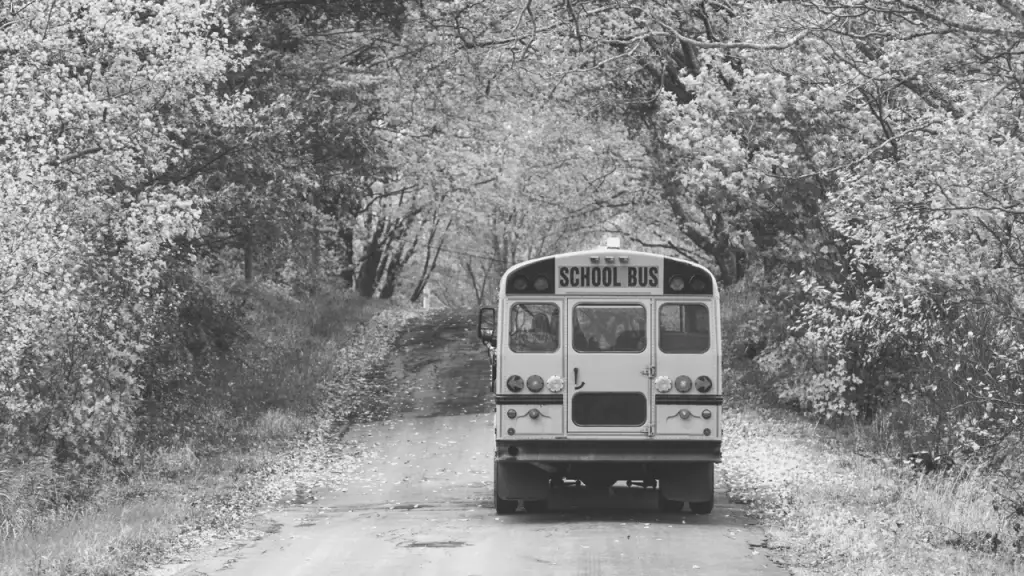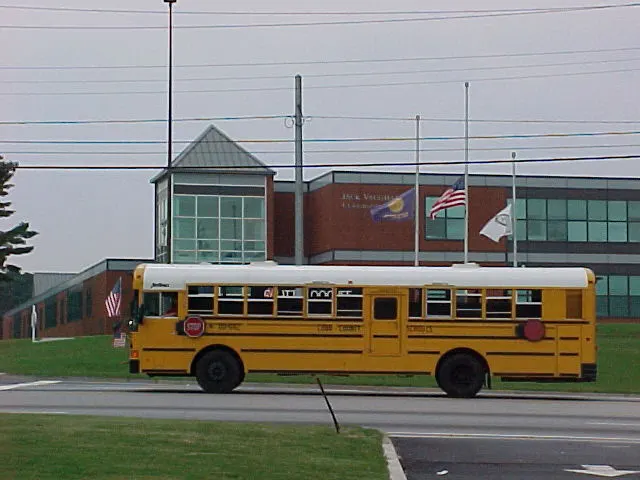When we see a school bus in traffic, we think of it as a big caution light. Not just because it’s yellow, but because its presence means we may have to stop unexpectedly.
It’s always a good idea to be careful around school buses because the safety of school children could be at risk. But when is it OK to pass a bus, and when do you need to stop in your tracks?
Let’s find out!
What Are the Two Types of School Buses?
Not all school buses are the same, but they all have the same important function – to safely deliver kids to and from school.
There are two main types of school buses, and they differ greatly in size.
What we consider a conventional, full-sized school bus is classified as a Type C bus. They’re about 40 feet long and carry about 80 passengers, usually three to a seat.
A Type A bus is much smaller, about half the length of a full-sized school bus. These are what some people refer to as a “short bus.” They have a van chassis and haul up to around 30 students.

What Should You Do If You Approach a School Bus With Amber Yellow Lights Flashing?
Sometimes you’ll encounter a school bus with flashing lights that are yellow or amber. They’re an alert that the driver is preparing to stop to load or unload one or more passengers. The driver will usually activate these caution lights well before a stop, sometimes several hundred feet before it.
When you see those yellow flashing lights, you should prepare to stop, too. The only leeway you have is whether you’re already in the process of passing the bus when you see the yellow lights start flashing. If so, proceed, but do it cautiously. Don’t speed up to try and race past the bus. That could create an even more dangerous situation.
What Should You Do If You Approach a School Bus With Red Signal Lights Flashing?
When the red flashing lights come on, this is a clear signal not to pass the bus. You should also see the bus’ mechanical stop-arm swing out to reinforce the message. It’s shaped like a stop sign and is near the front of the bus on the driver’s side.
At this stage, it’s just too dangerous to pass the school bus. There are lots of blind spots in these kinds of situations. You never know how quickly a student might unexpectedly dart in front of traffic.
Just sit in traffic and wait for the red lights to stop flashing and for the bus to start moving again. Then you can proceed, but keep in mind that the bus may make another stop soon.
To be clear, these traffic rules apply whether you’re behind a school bus in traffic or if you’re approaching from the other direction. Either way, you’ll need to stop until the student or students are safely out of harm’s way.

What Happens If You Go Around a School Bus?
The worst thing that can happen if you pass a stopped school bus is that you can injure or kill someone. Thankfully, these tragedies are rare, but they do happen.
There are other possible consequences, too. If a police officer witnesses your infraction, you will likely get a ticket and probably a pretty stiff fine. Laws vary from state to state, but fines can be a few hundred dollars. Insurance rates can rise, too, of course.
And just because there were no police around doesn’t mean you’re in the clear. In many states, school buses have cameras that record motorists passing illegally. So you could get a ticket or a court summons in the mail.
Why Are School Buses Yellow?
That distinctive dark yellow has been used for school buses since 1939, and it’s not just because someone loved the color.
A group of school transportation officials chose the standardized shade at an annual conference. They wanted a color that was highly visible to other motorists and would immediately identify these big vehicles as school buses.
There are certainly other brighter colors. The idea is that “school bus yellow” is easy to see in low-light conditions like early mornings and late afternoons. Also, the black lettering stands out nicely against the yellow backdrop.
Why Are School Buses So High Off the Ground?
Besides their color and flashing lights, school buses have other built-in safety features.
One of them is their height. They’re so tall, nearly 11 feet from the ground on the outside, that they don’t always fit beneath overpasses.
This means that the students are riding higher off the ground than they would be in traditional vehicles. In the event of a wreck, this extra clearance keeps them above the point of impact with the other vehicle.
In addition, the seats have extra-thick cushions and high backs to offer more protection.
Why Do School Buses Have Black Windows?
You may not have noticed what modern school buses look like inside because of the heavily tinted windows.
They do give students some privacy, but they also keep them more comfortable on their rides to and from school. The buses don’t have air conditioning, so the dark tint keeps the inside temperatures more bearable on hot, sunny days.
When Can You Pass a School Bus?
When you see a school bus on the road, and there are no flashing lights, you’re free to pass. There are other exceptions, too, such as when you’re on a divided highway with multiple lanes. Again, the specific laws vary from state to state.
The important thing to remember is to always be cautious when you’re near a school bus in traffic. The cargo they’re carrying is simply too precious to be careless or get in a hurry. And if you’re still not sure when you can pass or not, be sure and play it safe.
Discover the Best Free Camping Across the USA
To be honest with you, we hate paying for camping. There are so many free campsites in America (with complete privacy).
You should give it a try!
As a matter of fact, these free campsites are yours. Every time you pay federal taxes, you’re contributing to these lands.
Become a FREE CAMPING INSIDER and join the 100,000 campers who love to score the best site!
We’ll send you the 50 Best Free Campsites in the USA (one per state). Access the list by submitting your email below: